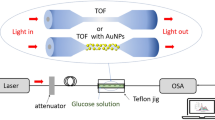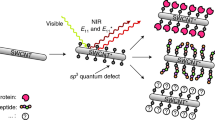Abstract
Molecular detection using near-infrared light between 0.9 and 1.3 eV has important biomedical applications because of greater tissue penetration and reduced auto-fluorescent background in thick tissue or whole-blood media. Carbon nanotubes have a tunable near-infrared emission that responds to changes in the local dielectric function but remains stable to permanent photobleaching. In this work, we report the synthesis and successful testing of solution-phase, near-infrared sensors, with β-D-glucose sensing as a model system, using single-walled carbon nanotubes that modulate their emission in response to the adsorption of specific biomolecules. New types of non-covalent functionalization using electron-withdrawing molecules are shown to provide sites for transferring electrons in and out of the nanotube. We also show two distinct mechanisms of signal transduction—fluorescence quenching and charge transfer. The results demonstrate new opportunities for nanoparticle optical sensors that operate in strongly absorbing media of relevance to medicine or biology.
This is a preview of subscription content, access via your institution
Access options
Subscribe to this journal
Receive 12 print issues and online access
$259.00 per year
only $21.58 per issue
Buy this article
- Purchase on Springer Link
- Instant access to full article PDF
Prices may be subject to local taxes which are calculated during checkout





Similar content being viewed by others
References
Dresselhaus, M. S., Dresselhaus, G. & Eklund, P. C. Science of Fullerenes and Carbon Nanotubes (Academic, San Diego, 1996).
Saito, R., Dresselhaus, G. & Dresselhaus, M. S. Physical Properties of Carbon Nanotubes (Imperial College Press, London, 1998).
Durkop, T., Getty, S. A., Cobas, E. & Fuhrer, M. S. Extraordinary mobility in semiconducting carbon nanotubes. Nano Lett. 4, 35–39 (2004).
Chen, R. J. et al. Noncovalent functionalization of carbon nanotubes for highly specific electronic biosensors. Proc. Natl Acad. Sci. USA 100, 4984–4989 (2003).
O'Connell, M. J. et al. Band gap fluorescence from individual single-walled carbon nanotubes. Science 297, 593–596 (2002).
Bachilo, S. M. et al. Structure-assigned optical spectra of single-walled carbon nanotubes. Science 298, 2361–2366 (2002).
Hartschuh, A., Pedrosa, H. N., Novotny, L. & Krauss, T. D. Simultaneous fluorescence and Raman scattering from single carbon nanotubes. Science 301, 1354–1356 (2003).
McCartney, L. J., Pickup, J. C., Rolinski, O. J. & Birch, D. J. S. Near-infrared fluorescence lifetime assay for serum glucose based on allophycocyanin-labeled concanavalin A. Anal. Biochem. 292, 216–221 (2001).
Salins, L. L. E., Ware, R. A., Ensor, C. M. & Daunert, S. A novel reagentless sensing system for measuring glucose based on the galactose/glucose-binding protein. Anal. Biochem. 294, 19–26 (2001).
Wray, S., Cope, M., Delpy, D., Wyatt, J. & Reynolds, E. Characterization of the near infrared absorption spectra of cytochrome aa3 and haemoglobin for the non-invasive monitoring of cerebral oxygenation. Biochim. Biophys. Acta 933, 184–192 (1988).
Klonis, N., Quazi, N. H., Deady, L., W., Hughes, A. B. & Tilley, L. Characterization of a series of far-red-absorbing thiobarbituric acid oxonol derivatives as fluorescent probes for biological applications. Anal. Biochem. 317, 47–58 (2003).
Kim, S. et al. Near-infrared fluorescent type II quantum dots for sentinel lymph node mapping. Nature Biotechnol. 22, 93–97 (2004).
Saxena, V., Sadoqi, M. & Shao, J. Degradation kinetics of indocyanine green in aqueous solution. J. Pharm. Sci. 92, 2090–2097 (2003).
Frangioni, J. V. In vivo near-infrared fluorescence imaging. Curr. Opin. Chem. Bio. 7, 626–634 (2003).
Strano, M. S. et al. Electronic structure control of single-walled carbon nanotube functionalization. Science 301, 1519–1522 (2003).
Bahr, J. L. & Tour, J. M. Covalent chemistry of single-wall carbon nanotubes. J. Mater. Chem. 12, 1952–1958 (2002).
Bahr, J. L. et al. Functionalization of carbon nanotubes by electrochemical reduction of aryl diazonium salts: A bucky paper electrode. J. Am. Chem. Soc. 123, 6536–6542 (2001).
Strano, M. S. et al. Reversible, band-gap selective protonation of single-walled carbon nanotubes. J. Phys. Chem. B 107, 6979–6985 (2003).
Strano, M. S. et al. The role of surfactant adsorption during ultrasonication in the dispersion of single-walled carbon nanotubes. J. Nanosci. Nanotechnol. 3, 81–86 (2003).
Moore, V. C. et al. Individually suspended single-walled carbon nanotubes in various surfactants. Nano Lett. 3, 1379–1382 (2003).
Zheng, M. et al. DNA-assisted dispersion and separation of carbon nanotubes. Nature Mater. 2, 338–342 (2003).
Zheng, M. et al. Structure-based carbon nanotube sorting by sequence-dependent DNA assembly. Science 302, 1545–1548 (2003).
Doorn, S. K., Heller, D. A., Barone, P. W., Usrey, M. L. & Strano, M. S. Resonant Raman excitation profiles of individually dispersed single walled carbon nanotubes in solution. Appl. Phys. A 78, 1147–1155 (2004).
Saito, R. et al. Probing phonon dispersion relations of graphite by double resonance Raman scattering. Phys. Rev. Lett. 88, 027401 (2002).
Saito, R. et al. Double resonance Raman spectra in disordered graphite and single wall carbon nanotubes. Mol. Cryst. Liq. Cryst. 387, 287–296 (2002).
Saito, R. et al. Chirality-dependent G-band Raman intensity of carbon nanotubes. Phys. Rev. B 64, 085312 (2001).
Xia, L. & McCreery, R. L. Structure and function of ferricyanide in the formation of chromate conversion coatings on aluminum aircraft alloy. J. Electrochem. Soc. 146, 3696–3701 (1999).
Okazaki, K., Nakato, Y. & Murakoshi, K. Absolute potential of the Fermi level of isolated single-walled carbon nanotubes. Phys. Rev. B 68, 035434 (2003).
Lu, J., R., Su, T., Georganopoulou, D. & Williams, D. E. Interfacial dissociation and unfolding of glucose oxidase. J. Phys. Chem. B 107, 3954–3962 (2003).
Saal, K. et al. Characterization of glucose oxidase immobilization onto mica carrier by atomic force microscopy and kinetic studies. Biomol. Eng. 19, 195–199 (2002).
Nakano, K., Doi, K., Tamura, K., Katsumi, Y. & Tazaki, M. Self-assembling monolayer formation of glucose oxidase covalently attached on 11-aminoundecanethiol monolayers on gold. Chem. Comm. 1544–1545 (2003).
Heller, A. Implanted electrochemical glucose sensors for the management of diabetes. Annu. Rev. Biomed. Eng. 1, 153–175 (1999).
Guiseppi-Elie, A., Lei, C. & Baughman, R. H. Direct electron transfer of glucose oxidase on carbon nanotubes. Nanotechnol. 13, 559–564 (2002).
Peter, L. M. Dynamic aspects of semiconductor photoelectrochemistry. Chem. Rev. 90, 753–769 (1990).
Tantra, R., Hutton, R. S. & Williams, D. E. A biosensor based on transient photoeffects at a silicon electrode. J. Electroanal. Chem. 538, 205–208 (2002).
Garjonyte, R., Yigzaw, Y., Meskys, R., Malinauskas, A. & Gorton, L. Prussian Blue- and lactate oxidase-based amperometric biosensor for lactic acid. Sensors Actuat. B 79, 33–38 (2001).
Moscone, D., D'Ottavi, D., Compagnone, D., Palleschi, G. & Amine, A. Construction and analytical characterization of Prussian Blue-based carbon paste electrodes and their assembly as oxidase enzyme sensors. Anal. Chem. 73, 2529–2535 (2001).
Karyakin, A. A., Karyakina, E. E. & Gorton, L. Amperometric biosensor for glutamate using Prussian Blue-based “artificial peroxidase” as a transducer for hydrogen peroxide. Anal. Chem. 72, 1720–1723 (2000).
Karyakin, A. A., Karyakina, E. E. & Gorton, L. Prussian-Blue-based amperometric biosensors in flow-injection analysis. Talanta 43, 1597–1606 (1996).
Acknowledgements
The authors are grateful for funding from the National Science Foundation (grant no. CTS-0330350), the School of Chemical Sciences at UIUC, and a grant from the Molecular Electronics group, Dupont Co. The authors thank J. Bahr for providing the blood specimen.
Author information
Authors and Affiliations
Corresponding author
Ethics declarations
Competing interests
The authors declare no competing financial interests.
Supplementary information
Supplementary Information
Supplementary Information, Fig S1 (PDF 1439 kb)
Rights and permissions
About this article
Cite this article
Barone, P., Baik, S., Heller, D. et al. Near-infrared optical sensors based on single-walled carbon nanotubes. Nature Mater 4, 86–92 (2005). https://doi.org/10.1038/nmat1276
Received:
Accepted:
Published:
Issue Date:
DOI: https://doi.org/10.1038/nmat1276
This article is cited by
-
Ratiometric fluorescent sensing of pyrophosphate with sp³-functionalized single-walled carbon nanotubes
Nature Communications (2024)
-
2D silicene nanosheets for the detection of DNA nucleobases for genetic biomarker: a DFT study
Structural Chemistry (2024)
-
A molecular pyroelectric enabling broadband photo-pyroelectric effect towards self-driven wide spectral photodetection
Nature Communications (2023)
-
A temperature sensor based on Si/PS/SiO2 photonic crystals
Scientific Reports (2023)
-
Wide near-infrared II emissions and LED application of Y2Ti2O7: Cr3+/Yb3+/Nd3+ phosphors
Applied Physics A (2023)



